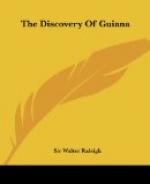On Thursday, the sixth of February, in the year 1595, we departed England, and the Sunday following had sight of the north cape of Spain, the wind for the most part continuing prosperous; we passed in sight of the Burlings, and the Rock, and so onwards for the Canaries, and fell with Fuerteventura the 17. of the same month, where we spent two or three days, and relieved our companies with some fresh meat. From thence we coasted by the Grand Canaria, and so to Teneriffe, and stayed there for the Lion’s Whelp, your Lordship’s ship, and for Captain Amyas Preston and the rest. But when after seven or eight days we found them not, we departed and directed our course for Trinidad, with mine own ship, and a small barque of Captain Cross’s only; for we had before lost sight of a small galego on the coast of Spain, which came with us from Plymouth. We arrived at Trinidad the 22. of March, casting anchor at Point Curiapan, which the Spaniards call Punta de Gallo, which is situate in eight degrees or thereabouts. We abode there four or five days, and in all that time we came not to the speech of any Indian or Spaniard. On the coast we saw a fire, as we sailed from the Point Carao towards Curiapan, but for fear of the Spaniards none durst come to speak with us. I myself coasted it in my barge close aboard the shore and landed in every cove, the better to know the island, while the ships kept the channel. From Curiapan after a few days we turned up north-east to recover that place which the Spaniards call Puerto de los Espanoles (now Port of Spain), and the inhabitants Conquerabia; and as before, revictualling my barge, I left the ships and kept by the shore, the better to come to speech with some of the inhabitants, and also to understand the rivers, watering-places, and ports of the island, which, as it is rudely done, my purpose is to send your Lordship after a few days. From Curiapan I came to a port and seat of Indians called Parico, where we found a fresh water river, but saw no people. From thence I rowed to another port, called by the naturals Piche, and by the Spaniards Tierra de Brea. In the way between both were divers little brooks of fresh water, and one salt river that had store of oysters upon the branches of the trees, and were very salt and well tasted. All their oysters grow upon those boughs and sprays, and not on the ground; the like is commonly seen in other places of the West Indies, and elsewhere. This tree is described by Andrew Thevet, in his France Antarctique, and the form figured in the book as a plant very strange; and by Pliny in his twelfth book of his Natural History. But in this island, as also in Guiana, there are very many of them.
At this point, called Tierra de Brea or Piche, there is that abundance of stone pitch that all the ships of the world may be therewith laden from thence; and we made trial of it in trimming our ships to be most excellent good, and melteth not with the sun as the pitch of Norway, and therefore for ships trading the south parts very profitable. From thence we went to the mountain foot called Annaperima, and so passing the river Carone, on which the Spanish city was seated, we met with our ships at Puerto de los Espanoles or Conquerabia.




